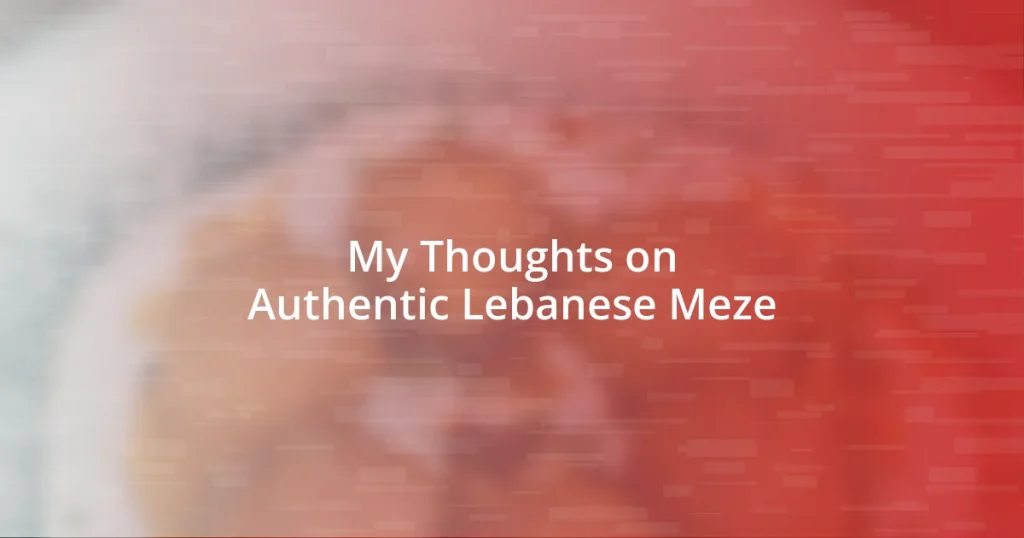Key takeaways:
- Lebanese meze embodies the spirit of hospitality and community, encouraging sharing and connection among people.
- Essential components of meze include a variety of dishes such as hummus, tabbouleh, and baba ghanoush that create a vibrant and memorable culinary experience.
- Pairing meze with complementary drinks like arak or mint lemonade enhances the overall dining experience, making gatherings more festive and enjoyable.

Introduction to Lebanese Meze
Lebanese meze is more than just a meal; it’s a vibrant feast of flavors and a cultural experience that invites sharing and connection. I remember the first time I sat down to enjoy a spread of meze at a friend’s home—colors, aromas, and countless small dishes filled the table. How could such a simple act of sharing food evoke so much warmth and joy?
Each bite of meze—from creamy hummus to tangy tabbouleh—tells a story of tradition and hospitality. I often think about the art of balancing these flavors and textures; it’s like creating a work of art on your plate. Have you ever thought about how food can forge relationships and bridge gaps between people?
What truly captivates me about Lebanese meze is its communal essence. It encourages conversation, laughter, and the kind of genuine connection that arises when people gather. Sharing plates of fragrant baba ghanoush or spicy labneh creates moments that linger long after the last bite. The experience is unforgettable; it makes me cherish not just the food but the people I share it with.

Cultural Significance of Meze
Meze is a cultural cornerstone in Lebanese society, reflecting the values of generosity and togetherness. I’ve often found that the act of sharing meze serves as an icebreaker in social gatherings. It brings together family and friends, creating an atmosphere where everyone feels welcome. Just thinking back to those vibrant dinners filled with laughter and stories brings a smile to my face.
The beauty of meze lies not only in its array of dishes but in what it symbolizes: hospitality and community. I recall a memorable evening in a bustling Beirut restaurant where the waiter brought an endless supply of baklava, falafel, and stuffed grape leaves. Each bite was a testament to the pride and love embedded in Lebanese cuisine, showcasing the richness of the culture. It’s fascinating how these small plates facilitate deeper connections between us, enveloping the moment in warmth and unity.
Even within the context of special occasions, meze holds a prominent place. During family celebrations or holiday gatherings, the table is adorned with an abundance of meze, serving as a focal point for the festivities. I realized that when we sit around a table filled with food, it’s not just about the meal; it’s about nurturing our relationships and sharing our stories. Every meze dish serves as a bridge to our past, invoking memories that bind us together.
| Cultural Aspect | Meze Significance |
|---|---|
| Hospitality | Meze exemplifies the Lebanese spirit of welcoming guests with generosity. |
| Community | It fosters connections, encouraging conversation and shared experiences. |
| Cultural Heritage | Each dish reflects the rich traditions and flavors of Lebanese history. |

Essential Components of Meze
The beauty of authentic Lebanese meze lies in its vibrant components, each playing a vital role in creating a memorable dining experience. I often liken the spread to a symphony, where every dish contributes to a rich tapestry of flavors, textures, and aromas. When I think of a perfect meze platter, ingredients like fresh, crunchy vegetables stand out to me. They not only add color but also bring a refreshing crispness that balances the richer dishes.
Here are some essential components that commonly grace a meze table:
- Hummus: A creamy chickpea dip, usually garnished with olive oil and paprika.
- Tabbouleh: A fresh parsley salad with tomatoes, bulgur, and a vibrant lemon dressing.
- Baba Ghanoush: A smoky eggplant dip that is both velvety and robust.
- Falafel: Crispy, deep-fried chickpea balls seasoned with spices, often served with tahini.
- Stuffed Grape Leaves (Warak Enab): Tender leaves wrapped around a savory rice and herb filling.
- Labneh: A thick, tangy yogurt that pairs beautifully with olives and bread.
Each dish tells a story, invoking memories of meals shared with friends during balmy summer evenings. One time, I vividly remember sitting outside and enjoying fresh tabbouleh while listening to laughter that mixed with the sounds of the bustling streets of Beirut. It’s these simple yet profound moments that make meze so special.

Popular Lebanese Meze Dishes
When it comes to popular Lebanese meze dishes, I can’t help but think of moutabbal, a smoky eggplant dip similar to baba ghanoush. I remember a lively dinner party at a friend’s house, where the moutabbal was the star of the show. As we dipped warm pita bread into the creamy mix, I could sense that familiar home-cooked warmth that envelops you like a snug hug. Isn’t it amazing how one dish can evoke such powerful feelings and memories?
Another standout is kibbeh nibblet, little shells of bulgur and minced meat. It’s interesting to see how this dish varies from region to region, reflecting local flavors in its preparation. Once, while traveling through Lebanon, I had the chance to taste a version filled with nuts and spices that danced on my palate. Each bite felt like a celebration! Have you ever thought about how a simple dish can connect you to a place and a community? That’s the magic of meze.
Let’s not forget about fattoush, a vibrant salad that’s not only refreshing but also packed with colors and flavors! It often features crispy pieces of pita bread mixed with ripe tomatoes, radishes, and crunchy cucumbers. I distinctly recall a sun-soaked afternoon when we indulged in fattoush by the seaside, the ocean breeze adding to the experience. Every bite was a reminder of how food can elevate a moment into a cherished memory. Isn’t it incredible how a simple salad can hold so much joy?

How to Prepare Authentic Meze
To prepare authentic meze, I always start with the freshest ingredients I can find. For example, buying locally-grown vegetables not only enhances the taste but also brings a certain vibrancy to each dish. There’s something utterly satisfying about chopping fresh parsley for tabbouleh or getting my hands messy by mixing the ingredients for kibbeh. They say, “you eat with your eyes”—and trust me, the right colors and aromas make all the difference.
I find that the key to an extraordinary meze lies in the balance of flavors. When I whip up baba ghanoush, I love achieving that smoky richness paired with a hint of lemon. Have you ever noticed how a splash of something acidic can transform a dish? It’s like adding a pinch of magic! For hummus, I often play around with spices—like sumac or cumin—to give my variation a personal twist. Every time I adjust a recipe, it reminds me of how meze is a reflection of our unique culinary stories.
Lastly, the presentation matters just as much as the preparation. Arranging meze on a large platter can turn your meal into an inviting feast. I enjoy layering the dips alongside colorful vegetables and crispy pita. One time, I added a few homemade pickles, and the delightful crunch they provided was nothing short of divine! Isn’t it fascinating how the joy of sharing meze goes beyond the food itself? It creates a sense of community, making every gathering feel like a celebration.

Tips for Serving Meze
When serving meze, I always like to think about variety. A colorful spread with a mix of flavors can create an inviting atmosphere. I remember one gathering where I included both creamy and crunchy textures—people mingled around the table, excitedly sharing their favorites. Doesn’t it feel more festive when there’s something for everyone to enjoy?
I find that serving meze in small portions keeps things interesting. Instead of large bowls, I often use small dishes to allow guests to sample different dips and snacks. One time, I even used mismatched but beautiful ceramics—each piece told a story and sparked conversation. Have you ever considered how the presentation can set the tone for the evening?
Lastly, don’t forget the importance of accompaniments! I never skip a warm basket of pita bread or a few olives alongside my meze. I recall hosting a friendly get-together where the simple act of sharing pita brought everyone together, transforming strangers into companions in no time. Isn’t it amazing how certain foods can foster connections and create memorable experiences?

Pairing Drinks with Meze
Enjoying meze isn’t just about the food; it’s about the whole experience, and I’ve found that the right drink can elevate it tremendously. For me, a glass of arak, the anise-flavored spirit, perfectly complements the assortment of flavors in meze. Every time I sip arak with a refreshing bite of tabbouleh, it feels like a celebration of Middle Eastern culture right in my own home. Have you ever paired a drink with food and felt everything click into place?
When friends come over, I always consider a non-alcoholic option, too, and my go-to is a chilled mint lemonade. Its bright and zesty flavor contrasts beautifully with the creamy textures of hummus and baba ghanoush. I remember a sunny afternoon where my friends and I gathered around a meze spread; the mint lemonade was such a hit that it became our unofficial signature drink. Do you often think about how non-alcoholic drinks deserve a place in these gatherings?
Wine can also play a fantastic role in complementing meze, particularly a light and fruity rosé. I recall a dinner party where I poured rosé for my guests while they nibbled on stuffed grape leaves. The subtle berry notes enhanced the overall flavor of the meal, making it a magical pairing. I honestly believe that the right drink can transport you to the sun-drenched hills of Lebanon, allowing you to savor every moment. What’s your favorite drink to enjoy with a meze spread?















